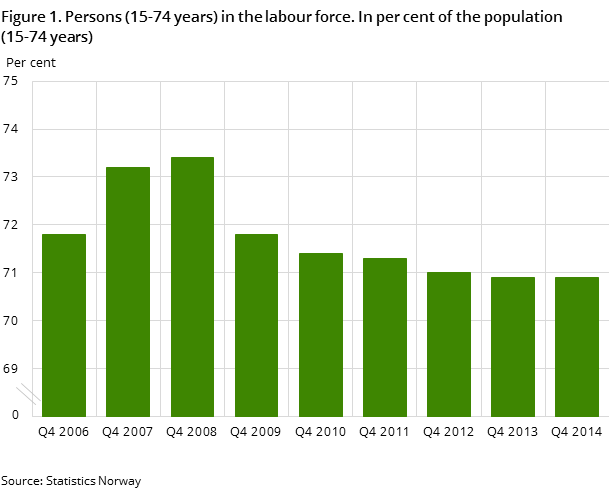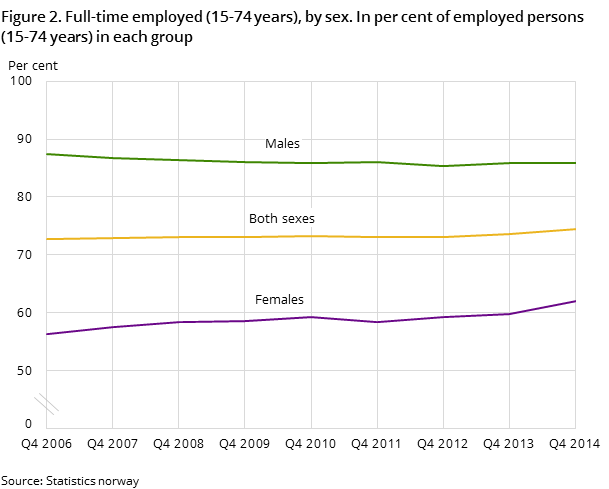Content
Published:
This is an archived release.
Higher participation rate among elderly
The labour force participation rate among those aged 55-66 increased by 3.9 percentage points from the 4th quarter of 2013 to the 4th quarter of 2014. There was a simultaneous decrease of 1.5 percentage points in the participation rate among those aged 15-24.
| 4th quarter 2014 | 4th quarter 2013 - 4th quarter 2014 | |||
|---|---|---|---|---|
| Absolute numbers | Per cent | Change in absolute numbers | Change in percentage points | |
| Labour force | ||||
| Both sexes | 2 745 000 | 70.9 | 38 000 | 0.0 |
| Males | 1 449 000 | 73.4 | 21 000 | 0.1 |
| Females | 1 296 000 | 68.4 | 17 000 | 0.1 |
| Employed persons | ||||
| Both sexes | 2 650 000 | 68.5 | 31 000 | -0.1 |
| Males | 1 391 000 | 70.4 | 11 000 | -0.5 |
| Females | 1 258 000 | 66.4 | 19 000 | 0.2 |
| Unemployed | ||||
| Both sexes | 95 000 | 3.5 | 7 000 | 0.3 |
| Males | 58 000 | 4.0 | 10 000 | 0.7 |
| Females | 38 000 | 2.9 | -2 000 | -0.2 |


The Labour Force Survey (LFS) shows that the labour force participation rate among the whole population aged 15-74 years remained stable from the 4th quarter of 2013 to the corresponding quarter of 2014. Among elderly people there was an increase in the number employed and a decrease in the number retired. Among young people there was a reduction in the number unemployed, while the number of people in education increased.
Rise in full-time employment among women
The LFS shows an increase of 31 000 in the number of employed persons from the 4th quarter of 2013 to the 4th quarter of 2014. The increase was in the number of full-time employed persons, especially among women. During the same period, the number of part-time employed persons decreased by 18 000, which related in its entirety to women. Despite this development, full-time employment is still far more common among men. In the 3rd quarter of 2014, the share of full-time employed persons was 87 per cent among men and 63 per cent among women.
Most of the increase in employment during the last year was in service industries, mainly in the private sector.
Higher unemployment and long-term unemployment
In the 4th quarter of 2014, there were 95 000 unemployed persons, up 7 000 from the corresponding quarter the previous year. The increase was among the long-term unemployed, i.e. persons who have been unemployed for more than 26 weeks. The share of long-term unemployed among the total unemployed in total was 36 per cent in the 4th quarter of 2014, up from 31 per cent in the 4th quarter of 2013.
Contact
-
Arbeidsmarked og lønn
E-mail: arbeidsmarked@ssb.no
-
Erik Herstad Horgen
E-mail: erik.horgen@ssb.no
tel.: (+47) 93 08 68 62
-
Håvard Hungnes Lien
E-mail: havard.lien@ssb.no
tel.: (+47) 40 90 26 06
